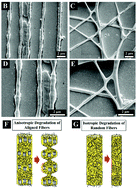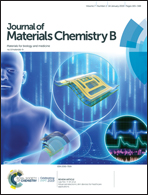Electrospinning of highly aligned fibers for drug delivery applications†
Abstract
Electrospinning is a straightforward, cost-effective, and versatile technique for fabrication of polymeric micro/nanofibers with tunable structural properties. Controlling the size, shape, and spatial orientation of the electrospun fibers is crucial for utilization in drug delivery and tissue engineering applications. In this study, for the first time, we systematically investigate the effect of processing parameters, including voltage, syringe needle gauge, angular velocity of rotating wheel, syringe-collector distance, and flow rate on the size and alignment of electrospun PLGA fibers. Optimizing these parameters enabled us to produce highly aligned and monodisperse PLGA fibers (spatial orientation >99% and coefficient of variation <0.5). To assess the effect of fiber alignment on the release of encapsulated drugs from these fibers, we incorporated dexamethasone, an anti-inflammatory drug, within highly-aligned and randomly-oriented fibers with comparable diameters (∼0.87 μm) and compared their release profiles. In vitro release studies revealed that the aligned fibers had less burst release (∼10.8% in 24 h) and more sustained release (∼8.8% average rate of change for 24 days) compared to the random fibers. Finally, the degradation modes of the aligned and random fibers after 25 days incubation were characterized and compared. The findings of this study can be applied for the development of 3D degradable aligned fibers for controlled drug release and tissue engineering applications.



 Please wait while we load your content...
Please wait while we load your content...